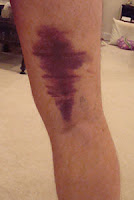The hamstrings are important players in low back and pelvic biomechanics. I have shown you a great beginners stretch to start opening these fun muscles (lots of people do not like stretching the hamstrings…I wonder why???), and now I would love to demonstrate a more advanced stretch.
The hamstrings, remember, are attached to the ischial tubes of the pelvis, which is essentially the “sit bones” as discussed in many yoga classes. So when stretching the hamstrings in the beginners stretch, most people feel it in the back of the knees, or the insertion point for the muscles. That’s good–it starts there. As you begin to open and are able to get deeper into the stretch, you will likely then feel it into the belly of the muscle, or the center of the hamstrings at the back of the thigh. Also good.
In the advanced high lunge stretch that I demonstrate in the video, you will feel it more in the origin of the muscle or up into the sit bones. Essentially you will feel it strongly at the point where the hamstrings meet the buttocks. I must reiterate: THIS IS AN ADVANCED STRETCH, so please go slowly. Don’t force anything. If you strain, pull or tear a hamstring, you will feel it for a long time. I tore my hamstring in 1999 and it took many years to get back to normal. Just be careful.
In the video I demonstrate the three different levels of the stretch–each one increasing in difficulty. Because of the depth of the stretch, you will also find this to be a great strengthening exercise for the buttock and the hamstring. If you hold the stretch for thirty seconds to a minute, you will be sore the next day.
Watch the video to learn a great hamstring strengthening workout and stretch for the upper hamstrings. Like I said, though, proceed with caution, as this is a little more advanced stretch. If you haven’t stretched your hamstrings much, definitely do not start here–begin with this first hamstring stretch. Otherwise, if you are ready…have fun.














